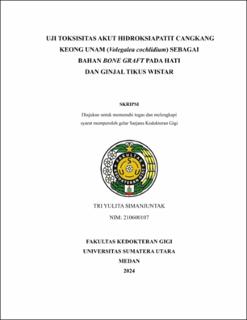Uji Toksisitas Akut Cangkang Keong Unam (Volegalea cochlidium) sebagai Bahan Bone Graft pada Hati dan Ginjal Tikus Wistar
Acute Toxicity of Hydroxyapatite from Unam Snail Shells (Volegalea cochlidium) as Bone Graft Material in the Liver and Kidney of Wistar Rats

Date
2024Author
Simanjuntak, Tri Yulita
Advisor(s)
Nasution, Aini Hariyani
Metadata
Show full item recordAbstract
Periodontal disease is a condition that causes inflammation and destruction of the tissues that support the teeth, including the alveolar bone. One of the treatments for bone resorption due to periodontitis is bone grafting. Hydroxyapatite, the main mineral component of bones and teeth, is widely used in bone reconstruction. A potential source of hydroxyapatite is the shell of the Unam snail (Volegalea cochlidium). This study aims to analyze the acute toxicity of Unam snail shell hydroxyapatite as a bone graft material on the liver and kidneys of female Wistar rats. A total of 30 female Wistar rats were divided into a treatment group given Unam snail shell hydroxyapatite and a negative control group given 0.5% Na-CMC. The test preparation was administered via oral tube, and observations were made for 14 days. After that, female Wistar rats were dissected for macropathological examination of the liver and kidneys, as well as analysis of serum SGOT, SGPT, and creatinine levels. The results showed that the LD50 value of Unam snail shell hydroxyapatite was more than 2000 mg/kgBW, without signs of toxicity, death, changes in body weight, organ enlargement, or macropathological abnormalities. In addition, a dose of 2000 mg/kgBW did not increase SGOT, SGPT, or creatinine levels. In conclusion, the hydroxyapatite of Unam snail shell is safe to use and has no acute toxic effects on the liver and kidneys of female Wistar rats.
Collections
- Undergraduate Theses [1910]
